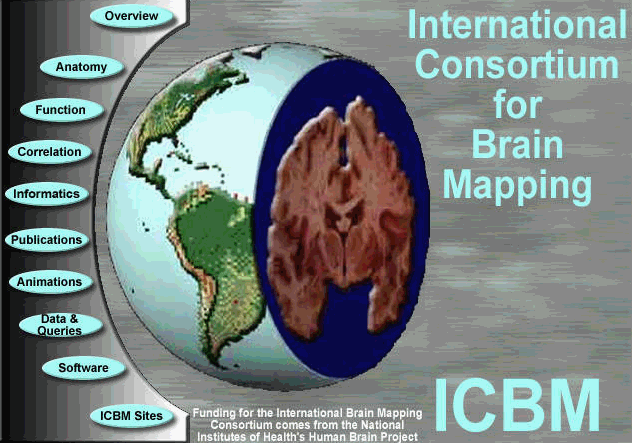The Interational Consortium for Brain Mapping
Proceedings of the Annual Meeting of the Human Brain Project, Bethesda, MD, June 1-2, 2000
John
Mazziotta1, Arthur Toga2, Roger
Woods1, Paul
Thompson 2,
Alan Evans3, Tomas Paus3, Louis Collins3,
Bruce
Pike3,
Peter
Fox4, Jack Lancaster4, Larry Parsons4,
Gregory Simpson5, Karl Zilles6,7
INTERNATIONAL CONSORTIUM FOR BRAIN MAPPING (ICBM)
1. Brain Mapping Center, UCLA School of Medicine, Los Angeles, CA
2. Laboratory of Neuroimaging, UCLA School of Medicine, Los Angeles, CA
3. Montreal Neurologic Institute, McGill University, Montreal, Canada
4. Research Imaging Laboratory, University of Texas at San Antonio
5. Department of Radiology, University of California at San Francisco
6. Heinrich Heine University, Düsseldorf, Germany
7. Institute of Medicine, Research Center Jülich, Germany

Abstract:
The development of a probabilistic atlas and reference system for the human brain has been extended in several ways since the last Human Brain Project Meeting. The first has to do with applying the informatics tools and algorithms developed by the ICBM Consortium to subject groups outside of the normal adult populations previously described. Both patients and children have been evaluated using probabilistic population-based atlases.In children, two important results have emerged. First, morphometric changes have been explored between adolescents (average age 14 years) and young adults (average age 25 years). When compared as a group using probabilistic approaches, the areas of significant structural remodelinginclude cortical regions and white matter of the prefrontal cortex bilaterally as well as symmetric changes in the inferior portions of the basal ganglia including the globus pallidus and nucleus accumbens areas.
Also in children, longitudinal, four-dimensional studies of growth patterns in the corpus callosum have been explored using probabilistic approaches within individual subjects and averaged as a group. These studies demonstrate selective areas of enlargement in the corpus callosum that vary as a function of age and cortical development. In childhood (3-6 years), the anterior portion of the corpus callosum (just posterior to the genu) change most rapidly while in later development (7-15 years), the isthmus of the corpus callosum demonstrates the most dramatic change concomitant with neocortical alterations in the parietal and temporal regions. Alzheimer's disease patients were also evaluated using probabilistic disease-specific atlases demonstrating regions of emerging cortical atrophy, most prominent in neocortical regions (superior parietal lobule) consistent with previous results provided by metabolic studies using positron emission tomography.
Second, during the past year, an international group of collaborators have been recruited to participate in our program. Through the inclusion of these new participants, we will be able to increase the total number of subjects in the atlas from 949 subjects to 7,000. The addition of these new subjects will increase the total number of DNA samples to 5,800. The expanded groups also include 342 twin pairs, half mono- and half dizygotic.
These new international collaborators come from sites as geographically disparate as Japan and Scandinavia, thus further increasing the racial and ethnic diversity of the subject sample. Given the large number of subjects that will be available in this program, true phenotype-genotype-behavioral comparisons will emerge as neuroscientific products of the neuroinformatics methods that are the basis for this consortium project.